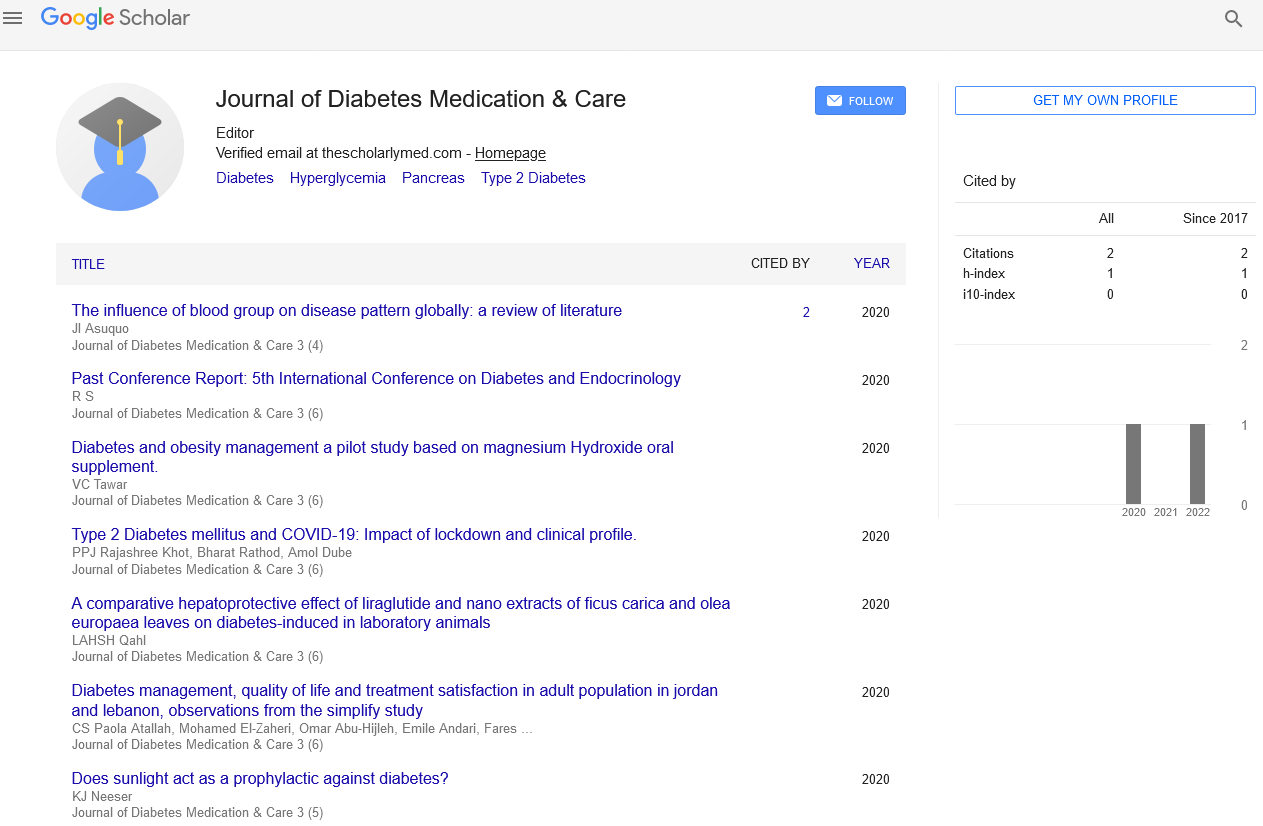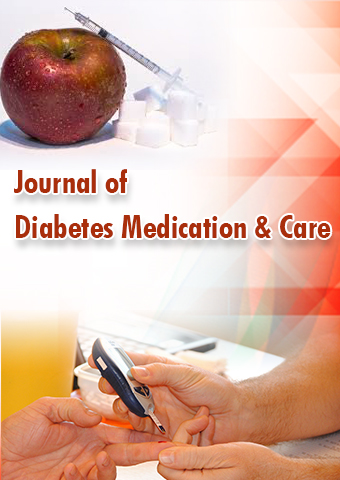Review Article - Journal of Diabetes Medication & Care (2022) Volume 5, Issue 4
Diabetes and the Abdominal Aortic Aneurysm
Ricky Jhonson*
Democritus University of Thrace, Komotini, Greece
Received: 02-Aug-2022, Manuscript No. JDMC-22- 72455; Editor assigned: 06-Aug-2022, PreQC No. JDMC-22-72455 (PQ); Reviewed: 20- Aug-2022, QC No. JDMC-22-72455; Revised: 23-Aug-2022, Manuscript No. JDMC-22-72455 (R); Published: 30-Aug-2022; DOI: 10.37532/ jdmc.2022.5(4).63-64
Abstract
The aim of this review is to delineate the association between abdominal aortic aneurysms (AAAs) and diabetes mellitus. Mechanisms for the underlying association are then discussed. Whilst the evidence that diabetes has an inverse relationship with aortic diameter may not aid the immediate management of AAA, it may help to identify high-risk groups for screening. Additionally, this observation may help demonstrate the differing cellular mechanisms behind aneurysmal and atherosclerotic disease, and in turn rationalise the search for pharmacological interventions of small AA.
Keywords
Diabetes • Glycaemia • Abdominal aortic aneurysm
Introduction
Diabetes mellitus affects around 4% of the UK population. The prevalence of diagnosed type 2 diabetes in men over 60 age the group most at risk of developing abdominal aortic aneurysms (AAAs) is estimated between 10-15% [1]. The prevalence of both diabetes and AAA has risen in recent years. Abdominal aortic aneurysm (AAA) is defined as a permanent dilatation of the abdominal aorta and is the tenth leading cause of death in older men. Despite theoretical common pathogenic mechanisms, the association between AAA and diabetes remains unclear and published work in this area is limited, incomplete and often conflicting. In this review, we scan the literature aiming to further delineate the prevalence of diabetes in people with AAA. In addition, we outline possible factors that explain the link between diabetes. The predominant risk factors for AAA are male sex, increasing age, smoking, hyperlipidaemia, hypertension and a family history. Because atherosclerosis shares similar risk factors it has traditionally been thought of as the underlying pathogenesis in AAA. The evidence above portraying a decreased prevalence of AAA in diabetics suggests that atherosclerosis is an associated feature, rather the Research in vitro and in vivo has described potential mechanisms involving the aortic wall that result in aneurysmal disease. This has been the subject of a recent review by Norman and we present an updated summary [2]. The walls of AAA show evidence of increased proteolytic activity with resulting collagen and elastin depletion. 24 Matrix metalloproteinases (MMPs) are a group of proteolytic enzymes which exhibit an increased activity in human aneurysmal tissue. 25 Of these, smooth muscle cell MMP-2 and macrophage-derived MMP-9 have been shown to be principally involved in the breakdown of matrix proteins, including elastin, and degradation of the vessel wall in aneurysmal disease. Elevated concentrations of both MMP-2 and MMP-9 have been found in patients with AAA and mice deficient in either MMP-2 or MMP-9 fail to develop aortic dilatation compared to wild-type mice.28 Whilst little is known about the factors that initiate the biological process of matrix destruction, there are a number of mechanistic possibilities changes that occur as a consequence of hyperglycaemia. It is therefore possible to speculate that the metabolic milieu of diabetes may impart a degree of resistance to aneurysmal disease by creating a stiffened aortic wall less prone to degeneration [3-4].
Description
Additional explanation may be related to the medical treatment of individuals with diabetes. Angiotensin-converting enzyme (ACE) inhibitors, aside from their effects on blood pressure, reduce vascular inflammation, increase elastin deposition and inhibit MMPs. ACE inhibitors prevent aortic expansion and rupture in animal models, and a populationbased case control study found that use of ACE inhibitors had a protective effect on AAA rupture. Simvastatin use has been shown to decrease MMP expression in the human AAA wall.46 Metformin decreases MMP-2 and smooth muscle cell proliferation in human aortic cells in vitro. Rosiglitazone has been shown to reduce the development and rupture of aortic aneurysms in a murine model48 and decrease expression of MMP- 9 in patients with diabetes. Because of the association of hypertension, atherosclerosis and renal impairment, diabetics are increasingly likely to be taking ACE inhibitors, statins and hypoglycaemic agents. The use of such medication may contribute to the apparent protective effect of diabetes in aneurysmal disease seen in the above studies. None of the studies reported have explicitly commented on the drug histories of recruited subjects [5]. The fibrinolytic system may play a role in the pathogenesis of AAA. Abdominal aortic aneurysms are associated with an intraluminal thrombus (ILT) 51 and the rate of expansion of large AAA correlates with ILT growth. A recent study found that the fibrin clot in type 2 diabetics is altered; being denser, less porous and more resistant to fibrinolysis. On one hand, one may subsequently expect increased ILT-mediated expansion and rupture of larger AAA in diabetic patients. However, the renewal of intraluminal thrombus by fibrinolysis releases components that are implicated in aneurysmal expansion, such as MMP-9 so the more degradation-resistant clot in diabetes may slow the rate of expansion caused by such mediators.
Plasminogen activator inhibitor-1 (PAI-1) inhibits the conversion of plasminogen to plasmin, thus suppresses fibrinolysis and reduces renewal of the intraluminal thrombus. Plasmin in turn converts pro-MMP to the active form. PAI-1 therefore decreases MMP production. Diabetes is known to predispose to cardiovascular disease and therefore the negative association with abdominal aortic aneurysms, documented by a number of studies, is seemingly paradoxical. The aim of this review was to analyse the link between AAA and diabetes from the evidence published thus far. Early population and case control studies appear to demonstrate an overall protective role for diabetes against the development of AAA, although further work into prevalence associations and biological mechanisms is clearly required, with specific attention to the type and duration of diabetes, as well as hypoglycaemic management and concurrent medications.
Acknowledgement
None
Conflict of Interest
No conflict of interest
References
- Mogensen CE, Christensen CK. The stages in diabetic renal disease: with emphasis on the stage of incipient diabetic nephropathy. Diabetes. 32, 64-78 (1983).
- Parving HH, Oxenboll B, Svendsen PA et al. Early detection of patients at risk of developing diabetic nephropathy: a longitudinal study of urinary albumin excretion. Actt Endocrinol. 100, 550-565 (1982).
- Viberti GC, Hill RD, Jarrett RJ et al. Microalbuminuria as a predictor of clinical nephropathy in insulin-dependent diabetes mellitus. Lancet. 1, 1430-1432(1983).
- Ruggenenti P, Cravedi P. The RAAS in the pathogenesis and treatment of diabetic nephropathy. Nat Rev Nephrol. 6,319-330 (2010).
- Zeeuw D, Remuzzi G, Parving HH et al. Albuminuria, a therapeutic target for cardiovascular protection in type 2 diabetic patients with nephropathy. Circulation. 110, 921-927 (2004).
Indexed at, Google Scholar, Crossref
Indexed at, Google Scholar, Crossref
Indexed at, Google Scholar, Crossref
Indexed at, Google Scholar, Crossref

